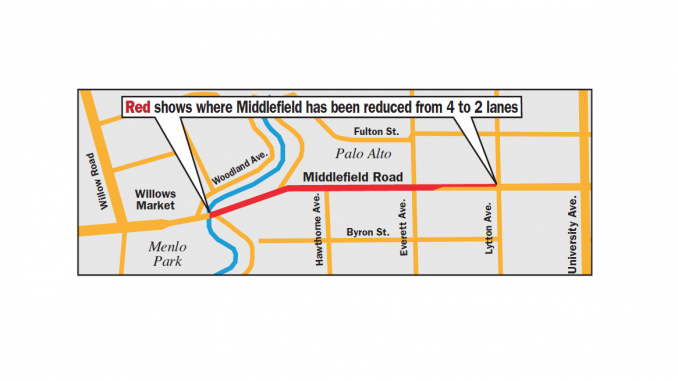
BY ALLISON LEVITSKY
Daily Post Staff Writer
Palo Alto City Council made its year-long road diet on Middlefield Road permanent without any public discussion — but residents told council in emails that the changes had been dangerous, wasteful of time and fuel, and “exhausting mentally and physically.”
The pilot reduced a four-lane route to two lanes on Middlefield north of Lytton Avenue. Council made the pilot permanent on Monday (Jan. 14) night.
A study by the city shows that the changes have pushed traffic onto other streets, particularly Guinda and Fulton streets, while reducing the crash rate in half, a five-year low for that part of Middlefield.
In letters to council, some residents hailed the safety improvements, while others said the sudden lane reduction feels dangerous.
“It is too draconian a solution to a problem, and bad for the environment,” Downtown North resident Janice Hough wrote to council on Saturday morning. “I think the Middlefield North Traffic Experiment should be ended, the barriers taken away and turn restrictions put back in place for peak hours.”
Hough admitted that during rush hour, it’s dangerous to turn left on Middlefield from Everett and Hawthorne avenues.
But the road diet forces downtown residents several blocks out of their way to make that left turn onto Middlefield.
Drivers using more fuel
“That is more gas used, and more pollution,” Hough wrote. “The narrowed Middlefield backs up traffic on a regular (basis). Which results in lots of idling and again, it’s bad for the environment.”
Everett Avenue residents Marion Odell and Jan Merryweather said they supported the changes.
“The improvements this past year have made my family feel so much safer every day,” Odell wrote to the council on Monday afternoon.
Roy Stehle, a Garland Drive resident and former member of the Federal Highway Administration’s National Intelligent Transportation Systems Architecture Technical Review Team, agreed.
“I understand the council’s desire to make traveling the road safe and efficient,” Stehle wrote on Saturday evening. “My experience over the pilot period is that this goal has not been achieved at two major intersections.”
Stehle said the block of Middlefield between University and Lytton avenues sees near-crashes regularly because cars drive straight forward from the left-turn lane.
Confusion, rapid lane changes
The intersection of Middlefield and Embarcadero roads now has frequent backups in the straight-through lane, leading left-turning drivers to have to wait through one or more signals when the left-turn lane is empty, Stehle said.
Daniel Moos wrote on Sunday morning that northbound through traffic has to move to the left lane before reaching University Avenue.
“The consequence is confusion, rapid lane changes, long backups due to getting stuck in the wrong lane, or illegally going straight instead of turning,” Moos wrote. “It’s dangerous, wasteful of time and fuel, increases pollution and congestion and exhausting mentally and physically.”
The city surveyed about 350 residents in the area by mail before, during the middle and at the end of the trial period. Surveys were mailed to residents living within two and a half blocks of Middlefield between Forest Avenue and Menlo Park.
Support for keeping the road diet increased from 33% to 66% during the trial period, according to the city.
